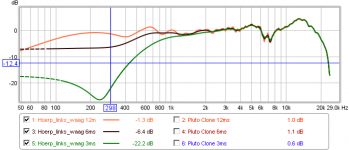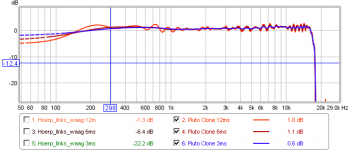more important than coherence of the source responsible for them.
What does "coherence of the source" mean? I suspect that you are using the word "coherence" incorrectly.
Wow! I tried it - listening with barrier, that is. The effect was not "mediocre".The crappier the speakers, the more amazing the barrier effect is. From standpoint of coherent speakers that disappear and take walls with them, the effect is mediocre at best.
So now I know how crappy and non-coherent my speakers really are.
Rudolf
Post up some meaning results from real measurements that back your contentions instead of asserting that software simulator, that doesn't even support reflections, supports your position on wall reflection impact on phantom image formation.
Of course, if speaker has tremendous beaming, by intent or otherwise that causes high frequency cues reflecting off of surfaces to be stronger than direct sound, then reflected sound effectively becomes the direct sound.
I demonstrate this very simply with Pluto Clone. With small nearfield listening triangle phantom image appears directly behind plane of speaker. If I point speakers at front wall, 2 meters away, phantom image appears behind wall. If I point speakers outwards, directly at side walls, phantom image appears very far behind plane of speakers. In each case only one phantom image forms, and it is based on higher frequency cues. All lower frequency cues arrive with Pluto Clones fully omni direct sound below about 2.5kHz, and have no bearing on direction and depth at which phantom image forms.
Markus, your self denial level is exceptionally high. *sigh*
Of course, if speaker has tremendous beaming, by intent or otherwise that causes high frequency cues reflecting off of surfaces to be stronger than direct sound, then reflected sound effectively becomes the direct sound.
I demonstrate this very simply with Pluto Clone. With small nearfield listening triangle phantom image appears directly behind plane of speaker. If I point speakers at front wall, 2 meters away, phantom image appears behind wall. If I point speakers outwards, directly at side walls, phantom image appears very far behind plane of speakers. In each case only one phantom image forms, and it is based on higher frequency cues. All lower frequency cues arrive with Pluto Clones fully omni direct sound below about 2.5kHz, and have no bearing on direction and depth at which phantom image forms.
Markus, your self denial level is exceptionally high. *sigh*
Changes in relative zero crossing times of the two slightly differing impulse responses are convolved with speaker signal, resulting in changes of spacial cues heard by each ear. This is independent of HRTF related changes of signals.
These are timing changes much less than 0.1ms. The differences allow localization of the speaker with small changes in head position naturally occurring while listening.
These effects become much worse when IMD is present.
When two such speakers are used for phantom image formation the impact is loss of spatial detail, and unmaking of speaker locations.
On what do you base your analysis on? It is not how I understand sound localization, which comes from Blauert, who is recognized around the world as the authority on this topic. What "authority" do you use to support your beliefs?
I have already suggested that you misuse the word "coherence", I hope that your claims are not also based in a misuse of the science.
Post up some meaning results from real measurements that back your contentions instead of asserting that software simulator, that doesn't even support reflections, supports your position on wall reflection impact on phantom image formation.
Sorry I don't get the point you're trying to make. What exactly is my "position on wall reflection impact on phantom image formation" and where and how did I use Earl's software to make my point
Wow! I tried it - listening with barrier, that is. The effect was not "mediocre".
So now I know how crappy and non-coherent my speakers really are.
Rudolf
Yes, you should experience great benefit. Your unbaffled drivers responsible for imaging cues are jiggling about on wires, and sound bouncing off of front pole piece of magnet add lots of variation to polar response based both on angle and frequency. Much of this is coming past driver frame.
BTW, your gated in room response is questionable choice; here are pics of your posted IR at listening position with 12ms, 6ms and 3ms windows:

For comparison Pluto Clone at listening position with 12ms, 6ms and 3ms:

For comparison Pluto Clone at listening position with 12ms, 6ms and 3ms:
You're living in an anechoic chamber?
It's fascinating what you know about my drivers what I seemingly don't know. But we haven't compared polars yet.Your unbaffled drivers responsible for imaging cues are jiggling about on wires, and sound bouncing off of front pole piece of magnet add lots of variation to polar response based both on angle and frequency. Much of this is coming past driver frame.
It is not easy for me to do my woofers justice with a single measurement, because the source is extended and reaches down to a listening angle of 45°. So everything below 500 Hz doesn't have much point in my diagram.
Rudolf
On what do you base your analysis on? It is not how I understand sound localization, which comes from Blauert, who is recognized around the world as the authority on this topic. What "authority" do you use to support your beliefs?
I have already suggested that you misuse the word "coherence", I hope that your claims are not also based in a misuse of the science.
Hair cells on basilar membrane fire on negative going zero crossings.
Zero crossings of a waveform remain fixed in time, regardless of waveform amplitude.
Relative timing of zero crossings is whole basis of directional determination <4kHz.
Panning mono signal between two speakers changes relative timing of zero crossings in sound pressures forming at openings of ear canals, and thus zero crossings detected by hair cells of the two ears.
Removing formation of these cues for panned stereo by preventing superposition summation of two speaker signals at each ear via divider leaves brain totally dependent on intensity differences for determining direction of source.
Coherence: If sound source behaves as point source then zero crossings for radiating sound maintain relative timing regardless of radiating direction.
This applies to directive sources, and is identical to having all radiated sound project back to a point.
A source such as full range speaker does not project back to point due to beaming. This is just one type of fail with full range drivers.
My authority is based on educational background in physics and math, and thousands of hours of measurement based experiments with sound.
Impact of IMD on speaker imaging performance is easy too.
Its easy creating panning in recording with delay v amplitude and listen with loudspeakers v headphones. Repetition with various band limited IR demonstrate impact of IMD on localization performance.
With Pluto Clone using supper steep crossover via DSP suppresses IMD formation and contributes to improved imaging performance at much higher volume than otherwise possible.
"Who's authority" is just a defensive branding game for not going out and Doing It Yourself and turning aside from sharing and exploring ideas that promote real improvements in speaker performance.
I don't agree with your assessment of how the cochlea works. The nerves do not fire synchronously with the waveform, that would completely discount place theory frequency detection. Localization does have some basis in the timing of "nulls in nerve firings but this is based on "envelope detection" and not on waveform detection.
No one has ever shown IMD to be an audible factor in loudspeakers, and, in fact, I have shown the exact opposite.
If you are your own "authority" with no review by other professionals in this field and you rely on this as your basis of expertise then I am afraid that I will have to write off most of what you say.
There is a scientific method and it works. Going around it is simply not science, even if you do have degrees in math and physics (like myself).
No one has ever shown IMD to be an audible factor in loudspeakers, and, in fact, I have shown the exact opposite.
If you are your own "authority" with no review by other professionals in this field and you rely on this as your basis of expertise then I am afraid that I will have to write off most of what you say.
There is a scientific method and it works. Going around it is simply not science, even if you do have degrees in math and physics (like myself).
Earl,No one has ever shown IMD to be an audible factor in loudspeakers, and, in fact, I have shown the exact opposite.
IMD is clearly audible when speakers are driven outside their linear range.
Small "full range" speakers trying to reproduce low frequencies, small tweeters driven too low, and PA speakers driven too hard all make my hearing suffer from IMD.
Dave Rat used to run two separate PA systems (until he purchased a more capable, ie louder system) for vocals and instruments to avoid IMD.
This video clearly shows the objectionable nature of IMD on vocal reproduction:
Dave Rat - IM distortion in monitor wedges - YouTube
Easy to hear the IMD even through the camera mic and warehouse sound.
Art
Art
When I say that non linear distortion is not audible I always mean for a system that is not "broken". If the nonlinear distortion is audible then the system is broken because it is not that difficult to design a system for which the nonlinearities are not audible.
The issue is that there is no one to one relationship between levels of IMD and perception, meaning that cutting the IMD in half does not also cut its perception in half. This may happen at extreme levels of IMD but at some point it simply becomes lost in our hearings masking and further reductions no longer make audible improvements.
When I say that non linear distortion is not audible I always mean for a system that is not "broken". If the nonlinear distortion is audible then the system is broken because it is not that difficult to design a system for which the nonlinearities are not audible.
The issue is that there is no one to one relationship between levels of IMD and perception, meaning that cutting the IMD in half does not also cut its perception in half. This may happen at extreme levels of IMD but at some point it simply becomes lost in our hearings masking and further reductions no longer make audible improvements.
The concept of time-intensity trading via toe-in has been published as early as the mid-1950s. Attached is a link to Ted Jordan's article of 1971 in Wireless World, but I recall reading a similar article in WW from the 1957 time frame. I THINK it was also by Jordan, but not positive. I did get the impression that the mid-1950's article was repeating what was already known.
http://www.ejjordan.co.uk/PDFs/Jordan_WW_Feb_71.pdf
The delay-line system in his article looks interesting, but unfortunately he doesn't explain how it is supposed to work. Possibly in the '70s (or earlier) this was something well known so he assumed an explanation wasn't needed. But do you know anything about how it is supposed to work, or other references that explain the delay-line speaker system?
Just curious and looking for something different to pursue,
Pete
- Status
- This old topic is closed. If you want to reopen this topic, contact a moderator using the "Report Post" button.
- Home
- Loudspeakers
- Multi-Way
- New study on loudspeaker placement